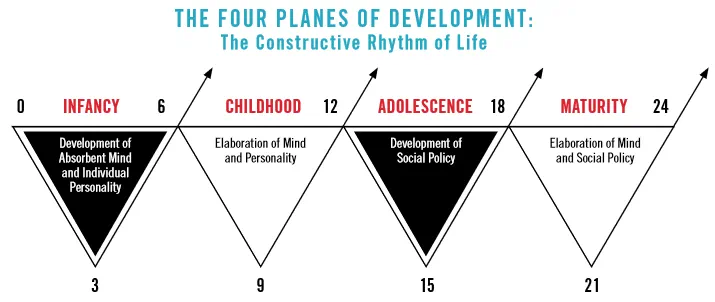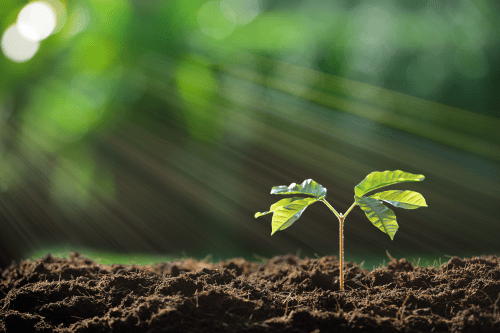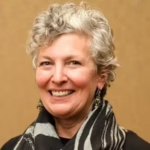These are fascinating and confusing times. It seems that harsh dialogue has become more normalized and that there is both an underlying sense of aggression and helplessness in the United States and in the world. On the rare occasion I listen to the news these days, I have to allow time to feel the sadness wash over me so I can go back to the work of the day. Once I breathe, soften, calm, and collect myself, I am more committed to consciously accepting the challenge to put into motion a little bit of what Charles Eisenstein calls “the more beautiful world our hearts know is possible” (2013).
In my 40 years as a Montessorian, the most important work I’ve done has grown out of Montessori’s overarching idea that we are to create a pathway for the New Human, “whose aspirations have transcended the temptation of personal advantages in the way of power and possessions, a human who has attained a high level of moral consciousness and can work for the good of humanity” (Grazzini, p. 37). To turn back to Eisenstein, these new humans will be the key to the more beautiful world our hearts know is possible, because they will possess a clarity of vision, a capacity for kindness, and an ability to shape society for a peaceful world.
All methods, materials, and lessons are meaningless unless we learn to capture the spirit of work that opens the door of possibility. When we as Montessorians falter, I think it is because we do not sufficiently understand that ultimately we must serve all of humanity, which means everyone. And implied is the notion that we must also serve the earth and be its stewards.
Montessori knew that to cultivate this pathway for the New Human, we must begin with the youngest children. Today, we read her words and look at her charts, and we know that the scaffolded experiences she prescribed are supported by current research in education and in child and adolescent brain development. I’m particularly drawn to research on mindfulness and attachment, which enhances Montessori’s work and gives us more developed tools for dealing with the effects of technology and trauma on children and adolescents in our schools.

The New Human
Montessori’s writing, and particularly her underlying principles, requires study and discussion. It is hard work to understand the depth of carefully sequenced lessons and experiences that she designed to create a genuine experience for the child. This work avoids simple answers. It evades black-and-white opinions. It frowns on bullet points. Simply put, the work invites us to study, discuss, engage, and participate in transformation, and, in doing so, it promises a better world. A year ago, I was asked to think about peace education at the Secondary level. In preparation, I began rereading Montessori’s writings. I thoroughly enjoy looking over her primary texts and always gain new insights. Several times, I was sure I was reading a new translation when, of course, I wasn’t. I decided to explore the idea of what Montessori called the New Man as the vehicle for peace (I choose to use the term “New Human”). That thread began to unspool as I explored the planes of development and remembered that the Montessori Method is peace education, guiding children and adolescents (and their teachers) within beautiful classroom environments to become more curious, caring, thoughtful, and responsible.
In each plane, developmental aspects serve to lay the groundwork for the next plane — beginning with the growth of focus and concentration and joy in work, and then, in the Elementary years, a fascination with the intricate nature of things, and next, at the Adolescent level, a sense of community and a love of humanity. The Montessori Method creates that foundation, while a further understanding of neuroscience enhances the key aspects that support focus, security, curiosity, compassion, and executive functioning of the brain. My quest to understand the New Human led me to the chart of the Constructive Rhythm of Life (page 34). It offers insight for how to support the development of this New Human.
How Do I Think We (Montessorians) Are Doing?
While Montessori education continues to be validated by studies in education and developmental psychology, the Montessori Method is still the only game in the world of education when it comes to having both a specific, scaffolded, spiraling approach to education and a clear vision and mission for peace.
If there is anything getting in the way of supporting the development of the New Human, it is that we become distracted and pulled away by lots of things that perhaps feel necessary but are often unimportant. We live in a culture that values speed over depth, quick fixes, cool new research and technology, and testing and standards that don’t match what or how we teach. And our own unaddressed implicit biases and assumptions get in our way as well.
We may have learned how to launch our students on the path to being ambassadors for global peace; however, we haven’t necessarily learned how to do that with one another. It’s hard for adults to know how to be clear, focused, and relational. And even if we do know what to do, it’s difficult to remember to do it. So often, our culture depends on the checklist (I do!) and is in a hurry (I just took a deep breath). That is why we need frameworks and procedures that provide a safe space for the soul of our work. Parker Palmer (2009, pp. 58–59) puts it this way,
Unfortunately, community in our culture too often means a group of people who go crashing through the woods together, scaring the soul away.…Under these conditions, the intellect, emotions, will, and ego may merge, but not the soul. We scare off all soulful things, like respectful relationships, goodwill, and hope.
We may get the checklist taken care of, but we can’t do the most important work without the presence of soul.
What Can We Do?
This is the hard part. And Montessori made it clear that we would have to do the hard parts to get to the good parts. We can begin to understand our own strengths and shortcomings and be honest about the ways in which we enhance and enliven those around us, as well as the ways in which we may be doing damage.
I speak with many Montessorians every year and find they are often discouraged by the pressures of regulations they have no control over, as well as their own lack of skill and background in effecting more Montessori-like systems for adults. What can we do about that?
Montessori (1939/1998, p. 102) tells us that
If we wish to become better teachers in this method, we must reconsider our task.…The main task is not to learn the method, but to open to a new way of life for the child. Therefore, it is necessary for the teacher to have an inner preparation.
Here’s the spoiler: I can’t tell you how to attain that inner preparation. And neither could Montessori (or she would have). The truth is, she was very specific about her method but not terribly specific about the inner preparation for the adult — at least not in terms of how to be the living example of the method in the larger world outside the classroom. I do know that we can’t do it without being as true as we can be to the intention of her work. We can’t do it if we are creating programs that are hyphenated (Montessori-Arts, Montessori-Technology, etc.) — not that we don’t use the arts with all students and technology with older students. And we can’t do it if we are starting our sentences with the ways in which we have updated her old-fashioned ideas for modern times — not that there aren’t modern ways we do the work. We don’t say, “We don’t have a farm because that was then and this is now.” We might say, “We do not have a farm, and here are the ways we implement the underlying principles that are embodied in the farm (real, purposeful, and joyful work through the care of the earth, stewardship of community, heartfelt service, and development of economy).” One thing is true for Montessorians doing things well — they are always true to Montessori’s intentions and what is appropriate for the healthy development of the child.
To help get things going, here are some ideas to nudge along the next level of our Montessori-like processes. (You may notice that this looks a bit like a checklist. I’m just getting my ideas organized).
- Create a support network with resources that can help hold the space to do our work with greater joy: therapy, massage, acupuncture, exercise, etc. It would be wise to increase our awareness of current developments in neuroscience, mindfulness, and attachment theory that can offer the repair our battered nervous systems need and provide safe havens for ourselves and our students, regardless of age or background. We can learn exercises and practices for moving stress responses through the body in healthy, life-affirming ways.
Just as diversity in the seed bank is insurance that we can survive a blight on the wheat crop, valuing diversity in the human population is a requirement for survival. when we cultivate critical thinking and human-heartedness in the souls of our students, we are helping them understand the inherent beauty of the world. By doing that, we nurture the only seeds we have in this world for lasting peace. (Donahoe, 2007, p. 3) - Figure out how to have lots of different kinds of people who love Montessori in our schools. It will not be possible to support the deep appreciation for all of humanity unless we can build our student body and staff to reflect the racial and socioeconomic diversity of our larger community.
- Consider these questions: what gets in our way of living the ideas that support the notion that everybody does better when everybody does better (Donahoe, 2013, pp. 18–20)? Are there clear and specific systems of self and peer accountability and communication that create a healthy community? (Check out the book reinventing organizations by Frederic Laloux.) Do the adults in a school have ways to come together for meetings and workshops that are fun, soulful, and productive all at the same time (Donahoe, 2010, pp. 46–47).
In this lifetime journey, I know this to be true: We need to understand Montessori’s call of hope and progression of the human spirit. And we need to enhance that story in order to release the old, mostly unconscious paradigms of scarcity and competition, getting over to get ahead, winners and losers, of old versus young, and of AMI versus AMS.
We Montessorians need one another — olders and youngers and all those in between. This work is not about the past or the future. We are the co-creators of this important time. It is my wish that we might look at ourselves and one another, and all around us, and accept the powerful invitation that is being offered, to take responsibility for now, this moment, in this world, on this beautiful earth, with our precious children and adolescents. Here it is, in front of us, the invitation to create a new pathway for healthy systems to emerge that were not possible before. A more beautiful world we all know is possible is dependent upon our imaginations and the new story. It is dependent on us.


